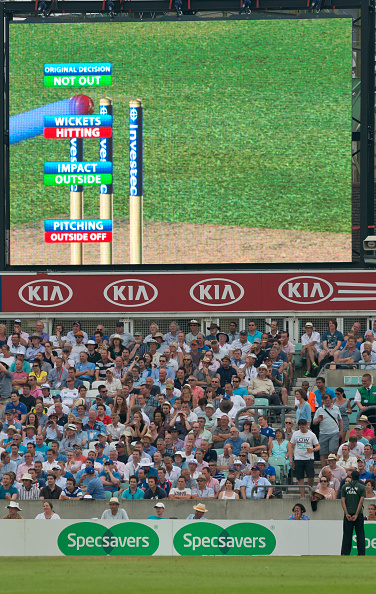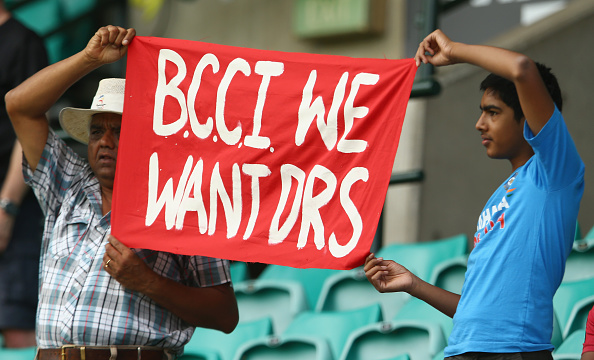
Decision Review System: India's journey with the DRS technology so far

Recently, the Board of Control for Cricket in India (BCCI) announced its willingness to implement the controversial Umpire Decision Review System (DRS) on a trial basis during the upcoming Test series against England. By doing so, they seem to have come full circle on their continued resistance to a technological aid that was introduced with an objective to eliminate obvious umpiring errors from the game.
When the DRS was first put under trial in 2008, it was India who first came forward to be a part of the experiment. A series later, they became its staunchest critic, much to the surprise of many who expected India to embrace the technology, having been at the receiving end of controversial decisions, most notably during the infamous Sydney Test.
Today, India are the only team to have not accepted the DRS in its present form.
Also Read: DRS: What made BCCI give it a go ahead?
India became one of the first teams to trial the Umpire’s Decision Review System, during their three-Test tour of Sri Lanka in 2008. Ironically, while most other teams have embraced the technology, much of India’s discontent with the DRS system also stems from their first-hand experience during that tour. Several ‘controversial’ decisions during that series, partly due to the fallacies of the technology which was then at a nascent stage, and partly due to their ill-judged choice of their reviews, meant India had a very bitter initiation to it.

At the end of the series, several senior players, including the captain on that tour and now the head coach, Anil Kumble, expressed their lack of confidence in its efficiency.
Kumble himself, as a bowler, was at the receiving end of several disappointing decisions during the course of the series.
The DRS system trialled in Sri Lanka was later officially launched in Pakistan’s Test tour of New Zealand in 2009 and continues to be used in all ICC events and bilateral ODI series, though not uniformly, depending on the mutual agreement between the two teams and its feasibility for the hosting cricket board.
Since DRS first came into force, several amendments have been made in its implementation and many advancements have been made in its technology to correct the flaws. But India have chosen to opt out until fully convinced of its foolproof efficiency. An overall success rate of 22% with DRS reviews so far also adds to a cause for their mistrust.
India’s first tryst with DRS and the controversies that followed
It was in the first Test of India’s tour of Sri Lanka in 2008, at Colombo. Indian off-spinner Harbhajan Singh found a spot in cricketing firsts as the first bowler to review the umpire’s decision. In the 46th over of the Sri Lankan innings on Day 2 of the match, he bowled round the wicket to the left-handed Malinda Warnapura, the ball pitched on middle and leg and hit the front pads. However, the review was turned down as the trajectory suggested it would go down the leg.
The next instance of a review happened in the 106th over. Zaheer Khan had Tillakaratne Dilshan given out caught behind off a delivery outside the off-stump. On review, replays indicated that the bat could have hit the ground and the original decision was overturned. Dilshan became the first player to have used the review system to overturn a decision after the umpire gave out – however the Snickometer later showed a faint edge. Later, Virender Sehwag became the first batsman to be given out by review after initially being given Not out. In total, India made 3 reviews in this Test – all of them unsuccessful.
In the second Test, Ganguly became the first Indian player to make a successful review when he got an lbw decision against him overturned. It was a top-spinner from Muralitharan that landed on an off stump line and struck his pads just around the off stump. It would become India’s only successful review out of 7 attempts in the match.
From bad, it went to worse in the final Test of the series. India made 10 reviews in the match, none of them successful. One of the biggest talking points in the series was a controversial decision in this Test. Kumble bowled to Thilan Samaraweera, a back of a length delivery which pitched outside the off stump and skidded towards middle and off. The original decision was Not out and Kumble asked for a review. Replays suggested there was no bat on it and would have hit the top of middle stump.
However, the original decision was upheld even as Kumble walked away making no attempt to hide his disappointment. Even Tendulkar, sitting in the dressing room, was seen signalling it was out with a raised finger and also suggesting it was skidding on rather than bouncing. At the end of the series, India had made about 20 review attempts, of which only 1 was successful. On several of these occasions, the Virtual Eye technology indicated the impact on the stumps, but the original decision was upheld. India lost a lot of faith in the ball tracking technology post the tour.
The DRS system was later used in India’s Test tour of England in 2011 which was the last bilateral series involving India that had DRS technology in use, without its application on lbw decisions. Again controversies refused to stay away, as the series was marred by accusations from former England skipper Michael Vaughan of VVS Laxman applying Vaseline on his bat to deceive HotSpot imagery. In fact, HotSpot will not be part of the DRS package that will be used for the Test series against England.
The International Cricket Council (ICC) requires that DRS be used uniformly in all ICC events. So, the DRS was first used in an ICC event, during the 2011 ODI World Cup, incidentally co-hosted by India along with Sri Lanka and Bangladesh. During the tournament, India made DRS reviews 18 times, of which only 4 were successful. Controversy broke out in a Group B match between India and England, when Ian Bell was adjudged not out to an lbw appeal off Yuvraj Singh’s bowling due to a clause in the DRS that makes it almost impossible to overturn the original Not Out decision if the point of impact of the ball is found to be 2.5meters or more from the stumps.
In this case, Bell was more than 2.5 metres down the pitch when he was struck - a distance beyond which the ball tracking technology is considered to lose accuracy in predicting path. Bell went on to score many more runs and what could have been an easy win for India ended in a tie, much to the fury of Dhoni. The rule was later struck down, midway through the tournament.
The DRS which came into effect in ODIs since 2011 was also used in the ICC Champions Trophy 2013 in England - where India successfully used it thrice – and in the 2015 World Cup in Australia – where India made 1 successful review out of 4 attempts. Since it has not yet been introduced in the T20 format, the 2016 T20 World Cup in India did not see the use of the DRS technology.
A second chance
As mentioned earlier, while India had stayed away from using DRS, several improvements were made to the technology and its implementation, and though it still may not guarantee 100% efficient decision making, it is still better than the lasting impression that it has left on the Indians from earlier experience.

In contrast to Dhoni who had his reservations against various aspects of the DRS technology, India’s Test captain Virat Kohli has taken a more open stance. He has expressed his keen interest to use DRS in its current form with its few existing flaws. Kumble, who had in his capacity as chairman of ICC's Cricket Committee, gone to the Massachusetts Institute of Technology which worked on the upgraded technology of DRS, may have returned positive feedback to the team and the bosses at the BCCI.
Also Read: Things to look forward to from DRS
In fact, the decision to trial the upgraded system in the upcoming series was made only after Kumble and the BCCI president Anurag Thakur attended a meeting with ICC and Hawk Eye representatives, who made a detailed presentation of the upgraded version of the DRS technology to them.
While India’s acceptance of DRS is most welcome, much of its fate will hinge on how much it works to the favour of India in the five Tests to come, where it will be put to severe test by the spin-friendly conditions that will yield a lot of lbw and bat-pad referrals. A few reviews going India’s way could perhaps be the perfect healer to India’s long-lasting DRS apprehensions.